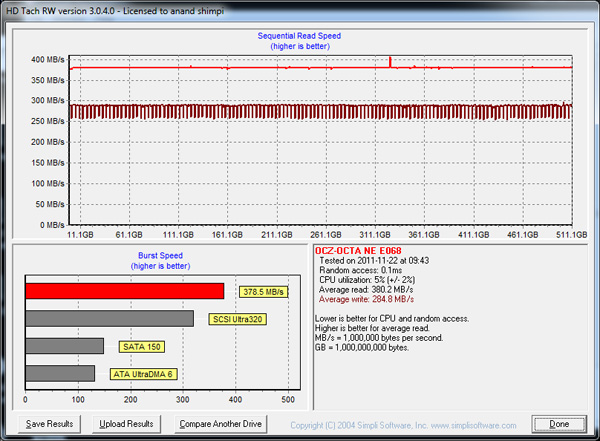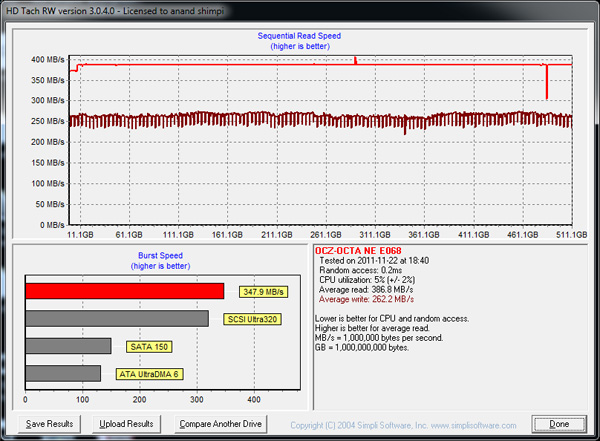The OCZ Octane Review (512GB)
by Anand Lal Shimpi on November 23, 2011 12:00 PM ESTPerformance Over Time & TRIM
Testing TRIM functionality is important because it gives us insight into the drive's garbage collection algorithms. OCZ insists the Octane has idle time garbage collection, a remnant of the original Indilinx drives, however in my testing I could not get the idle GC to do anything once I put the drive into a highly fragmented state. Let's start at the beginning though. The easiest way to ensure real time garbage collection is working is to fill the drive with data and then write sequentially across the drive. All LBAs will have data in them and any additional writes will force the controller to allocate from the drive's pool of spare area. This path shouldn't have any bottlenecks in it; the process should be seamless. As we've already seen from our Iometer numbers, sequential write performance at low queue depths is around 280MB/s. A quick HD Tach pass of a completely full drive gives us the same result:

The Octane works as expected here, but now what happens if we subject the drive to a ton of 4KB random writes? Unfortunately this is where the Octane falls short. If we just throw a few minutes of random writes, constrained to a small LBA range, at the Octane its performance hardly varies:

However once the Octane passes a threshold of fragmentation, the performance drop is considerable. Our standard test involves a 20 minute, 4KB random write across all LBAs at a queue depth of 32. A sequential write pass across the drive afterwards took place at between 2 and 7MB/s. Since our test drive was a 512GB model, there simply wasn't enough time to conduct a full pass in the course of preparing this review. Instead I did a shorter test with HD Tach to give you some indication of what happens to the Octane under a highy random load without TRIM:

Performance drops considerably. A single TRIM pass restores performance to new. I did have one TRIM test where only the latter half of the drive seemed to TRIM but I couldn't get the same result more than once. Now the question is, what does all of this mean?
If you have TRIM enabled on a desktop platform with a client (read: non-server) workload, none of this should matter to you. TRIM works and there doesn't appear to be any weird lag or bottlenecks in the GC path. If you don't have TRIM enabled (read: OS X) with a client workload, this could warrant a pass. The only reason I'm hesitant to recommend the Octane for use with a TRIM-less OS X installation is because I'm not entirely sure the drive will recover from this ultra low performance state without TRIM. Sequential writing alone may not be enough to adequately restore the Octane's performance. Normally idle GC would be enough, but it seems as if things get slow enough the drive's idle GC can't do much. I suspect all of this is stuff that OCZ can tweak via firmware, but I need more time with the drive to really be certain.
Finally if you're deploying a server with lots of random writes, the Octane isn't for you. OCZ will eventually release an Everest based drive for the enterprise, but the Octane is not that drive.










75 Comments
View All Comments
jwilliams4200 - Wednesday, November 23, 2011 - link
"OCZ sent us a 512GB version with sixteen NAND packages and four 8GB die per package. We typically don't see any interleaving benefits beyond two die per package, so I'd expect similar performance between the 512GB drive and the 256GB version (despite the significant difference in specs)"What a strange thing to say. Do you really mean that you think that despite OCZ quoting a 270MB/s sequential write speed for the 256GB model (vs. 400MB/s for the 512GB model), that the two sizes will actually have the same sequential write speed?
If so, I'd be willing to be a lot of money with you that you are wrong.
jwilliams4200 - Wednesday, November 23, 2011 - link
be -> betAnand Lal Shimpi - Wednesday, November 23, 2011 - link
The only reason I said that is because I wasn't really able to hit OCZ's "400MB/s" in our Iometer tests. Instead I got 280MB/s, which is closer to what OCZ specs the 256GB version at.I'm 100% ok with being wrong and I'll be sure to point it out if I am in the next review :)
Take care,
Anand
jwilliams4200 - Wednesday, November 23, 2011 - link
But you measured 395 MB/s for the 512GB Octane sequential write with AS-SSD.It seems that the Octane sequential write speed varies a lot (other review sites have measured 348 MB/s with AS-SSD). Maybe it depends a lot on the block size, or on the size of the test file (span), or on whether the SSD is in a used or fresh state.
Anand Lal Shimpi - Wednesday, November 23, 2011 - link
But if you look at HDTach and Iometer the perf is down at 280MB/s. I'm not entirely sure what's going on with AS-SSD...Take care,
Anand
gevorg - Wednesday, November 23, 2011 - link
"I believe OCZ needs a good 12 months of an Intel or Samsung-like track record to really build confidence in its products."I completely agree!!
LoneWolf15 - Thursday, November 24, 2011 - link
""I believe OCZ needs a good 12 months of an Intel or Samsung-like track record to really build confidence in its products."I completely agree!! "
That makes three of us. I'll say one more --they also need to build a proven track record of customer service as well.
Right now, Intel, Crucial (specifically the m4), and Samsung are the choices I look at if a client needs an SSD.
MrSpadge - Wednesday, November 23, 2011 - link
What's this "double write endurance" and "faster boot" about?MrS
iwod - Wednesday, November 23, 2011 - link
I think it just shows how Random Read is EXTREMELY important to Real world workloads.Since we have already establish Random Write over 40 - 50MB/s doesn't make any difference, And Seq Read Write matter a lot less then Random Read.
Taft12 - Wednesday, November 23, 2011 - link
Fully agree here, in fact random read is the only thing that really matters as far as anything you'd ever notice in real world desktop use.Anything more is benchmark porn (no offense to the fetishes of many AT readers)
Longevity and stability is most important by far, too bad a benchmark can't determine that.